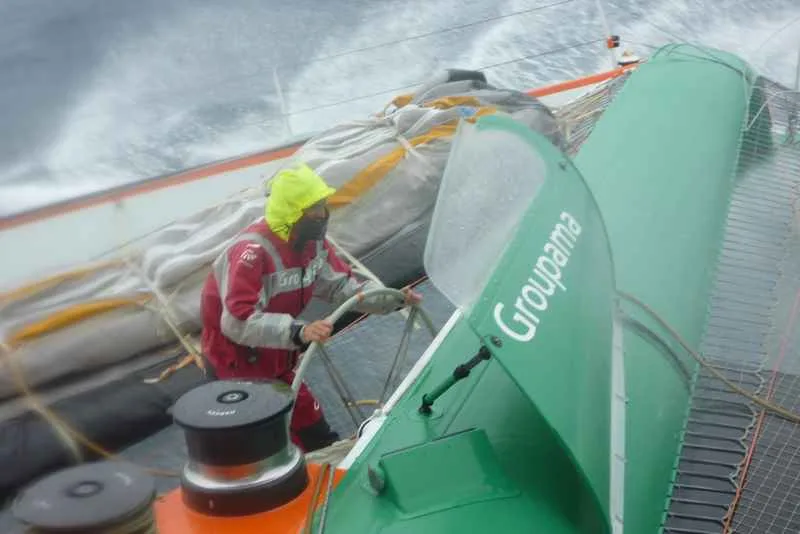
Groupama 3 is almost back inside the Jules Verne Trophy reference time as she approaches the longitude of Cape Leeuwin, just seven days after passing Cape Agulhas! The final stage of the Indian Ocean seems all set to see the giant trimaran get back in the saddle…
124 miles separate the two boats on this 21st day at sea. Since the Crozet Islands the situation has reversed and Groupama 3 has constantly proven to be faster (at times ten knots quicker) than Orange 2 in 2005… With a W to NW’ly wind of around twenty knots, Franck Cammas and his men are sailing safely, without putting too much pressure on the machine and without demanding excessive amounts of effort from the crew. The past 24 hours have been more active in terms of manoeuvres however.
“Everything’s going very smoothly: we’re being dealt weather conditions which aren’t particularly difficult for an Indian Ocean. We’re still chasing after Orange 2 but we’ve greatly reduced our deficit. On Saturday there was even some sunshine and we had a magical night with an extraordinarily starry sky. It’s my first adventure offshore and you simply can’t tire of it: time just flies by! I’m excited at the idea of passing Cape Leeuwin on Monday morning and after that it will be the Pacific and the Horn: it’s fantastic! Added to that I’m on watch with Thomas Coville and Steve Ravussin and we get on very well” said Bruno Jeanjean at the 1130 UTC radio link-up with Groupama’s Race HQ in Paris.
Leeuwin ahoy
Under large gennaker, staysail and full mainsail, Groupama 3 is still making headway at an average of nearly thirty knots and tonight’s menu promises more of the same. As such Franck Cammas and his nine crew should cross the longitude of Cape Leeuwin late tonight or in the early hours with a deficit of less than five hours in relation to the reference time. Above all they are set to achieve the best time over this section of the course between Cape Agulhas and the SW tip of Australia…
“We’re really not feeling fatigued because we’ve never had to draw on our reserves! Of course above thirty-five knots of speed, you get shaken about quite a lot and you have to hang on whilst you’re in your bunk, but we’re sleeping well. Thomas told me that this particular crossing of the Indian has gone fairly smoothly in relation to what he’s experienced here in the past… We’re still sailing on relatively well organised seas and for the time being, we’ve only had one 40 knot gust. Furthermore, it’s not cold and the sea temperature is still 10°C. Today we’ve had a good day of manoeuvring, switching between the large and small gennaker, with two gybes: that livens things up on deck!”
The crew has also had the time to perform several check-ups and all’s well aside from the natural wear on the sheets. The `sailing instructions’ are still the same: go fast effortlessly! And from this perspective, Groupama 3 is right on track to complete her passage across the Indian Ocean.

Groupama 3’s log (departure on 31st January at 13h 55′ 53” UTC)
Day 1 (1st February 1400 UTC): 500 miles (deficit = 94 miles)
Day 2 (2nd February 1400 UTC): 560 miles (lead = 3.5 miles)
Day 3 (3rd February 1400 UTC): 535 miles (lead = 170 miles)
Day 4 (4th February 1400 UTC): 565 miles (lead = 245 miles)
Day 5 (5th February 1400 UTC): 656 miles (lead = 562 miles)
Day 6 (6th February 1400 UTC): 456 miles (lead = 620 miles)
Day 7 (7th February 1400 UTC): 430 miles (lead = 539 miles)
Day 8 (8th February 1400 UTC): 305 miles (lead = 456 miles)
Day 9 (9th February 1400 UTC): 436 miles (lead = 393 miles)
Day 10 (10th February 1400 UTC): 355 miles (lead = 272 miles)
Day 11 (11th February 1400 UTC): 267 miles (deficit = 30 miles)
Day 12 (12th February 1400 UTC): 247 miles (deficit = 385 miles)
Day 13 (13th February 1400 UTC): 719 miles (deficit = 347 miles)
Day 14 (14th February 1400 UTC): 680 miles (deficit = 288 miles)
Day 15 (15th February 1400 UTC): 651 miles (deficit = 203 miles)
Day 16 (16th February 1400 UTC): 322 miles (deficit = 376 miles)
Day 17 (17th February 1400 UTC): 425 miles (deficit = 338 miles)
Day 18 (18th February 1400 UTC): 362 miles (deficit = 433 miles)
Day 19 (19th February 1400 UTC): 726 miles (deficit = 234 miles)
Day 20 (20th February 1400 UTC): 672 miles (deficit = 211 miles)
Day 21 (21th February 1400 UTC): 584 miles (deficit = 124 miles)
WSSRC record for traversing the Indian Ocean (from Cape Agulhas to Southern Tasmania)
– Orange 2 (2005): 9d 11h 04′
Reference time from Cape Agulhas to Cape Leeuwin
-Orange 2 (2005): 7d 05h 35′